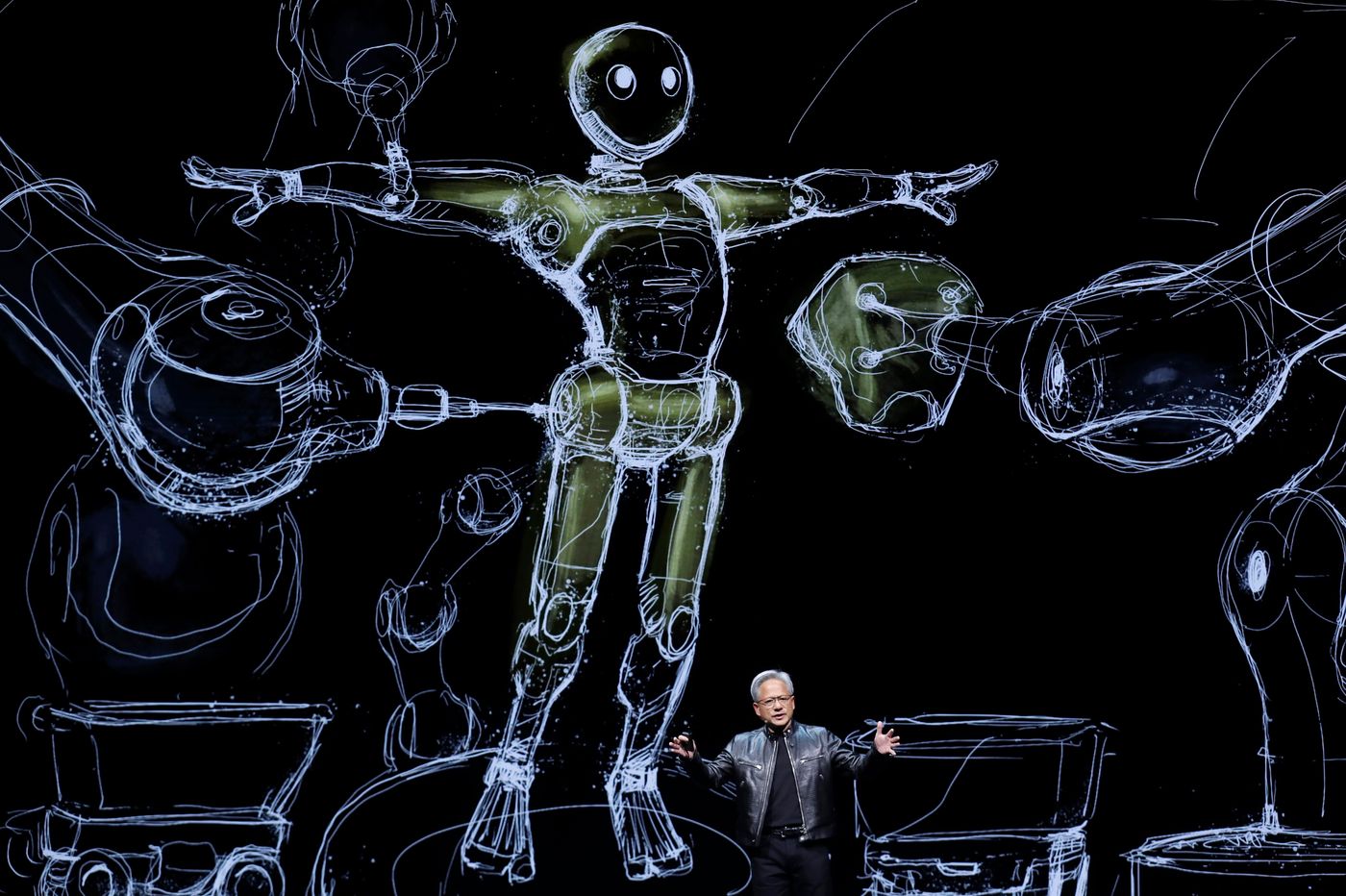Chips and Taiwan Are a New Cloud for Tech Earnings
Security for Taiwan is vital to the chip industry—and to all the tech companies that use those chips
Chip politics are no longer just the chip industry’s problem.
Investors got a sharp reminder last week of just how politicized the semiconductor industry has become—especially ahead of a U.S. presidential election. First came a report that the Biden administration is considering more severe trade restrictions to keep advanced chip manufacturing tools out of the hands of Chinese companies.
Then Bloomberg Businessweek ran an interview with Donald Trump in which the former president and current Republican nominee raised doubts about whether the U.S. under his administration would defend Taiwan from China unless the island democracy starts paying for U.S. protection.
The news poured more than a splash of cold water on what has been a red-hot sector. Chip stocks crashed Wednesday following the initial reports and kept falling. The PHLX Semiconductor Index closed Friday with a weekly loss of nearly 9%. The index had been up 40% for the year to date ahead of the damaging reports after having surged 65% this past year—its best annual performance since 2009.
Semiconductor investors have long been factoring in the growing risk of lost sales to China due to export restrictions. But Trump’s comments about Taiwan add a whole new element of risk: The island is a major hub for manufacturing the world’s most advanced semiconductors and less-advanced but vital ones that go into products such as thermostats, cars and medical devices.
This isn’t just about Taiwan Semiconductor Manufacturing , the chip-making giant better known as TSMC that produces key processors for companies such as Nvidia , AMD and Apple . The island is also home to many other suppliers of key components used in final chip products. During a speech at a conference in Taipei in June, Nvidia Chief Executive Officer Jensen Huang praised Taiwan as “the unsung hero” of the computer industry, showing a slide of more than 100 companies he described as “treasured partners” to the artificial-intelligence chip star .
Hence, Trump’s comments “threw gasoline on an already raging China restriction issue that had the chip stocks in turmoil already,” independent semiconductor analyst Robert Maire wrote in an email. Whatever the intent behind them, they may have raised the odds of an attempt at forced “reunification” by China by creating doubt about America’s response.
Military action against Taiwan wouldn’t just hit chip companies but also the many, many businesses that use those chips. It isn’t a small list: Chips sit at the heart of the cloud computing services offered by Microsoft , Google and Amazon as well as the iPhones sold by Apple and the EVs sold by Tesla , whose CEO is now one of Trump’s largest backers.
Armed conflict between mainland China and Taiwan is hardly a foregone conclusion, even if Trump wins in November. But investors who mostly have been trading on AI hype need to factor a new element of risk into their models—especially since political rhetoric will only grow louder ahead of the election. U.S. policy toward China is a major issue for both parties, and the question of defending Taiwan will very likely arise again.
This comes as investors are also grappling with how to value the AI opportunity, especially as coming tech-earnings reports will likely continue to feature more AI investments than actual revenue.
Risks there still aren’t fully baked in. The Nasdaq Composite Index has come down a bit from the record high it hit earlier this month, but is still up 18% for the year, which is more than double the Dow’s return. And the six megacap tech giants—Apple, Microsoft, Nvidia, Amazon, Google-parent Alphabet and Meta Platforms —have added a collective $3.7 trillion in market value in that time. That is an awfully big bet on a sector that no longer has the luxury of staying out of the political fray.
 Copyright 2020, Dow Jones & Company, Inc. All Rights Reserved Worldwide. LEARN MORE
Copyright 2020, Dow Jones & Company, Inc. All Rights Reserved Worldwide. LEARN MORE
A divide has opened in the tech job market between those with artificial-intelligence skills and everyone else.
A 30-metre masterpiece unveiled in Monaco brings Lamborghini’s supercar drama to the high seas, powered by 7,600 horsepower and unmistakable Italian design.
A divide has opened in the tech job market between those with artificial-intelligence skills and everyone else.
There has rarely, if ever, been so much tech talent available in the job market. Yet many tech companies say good help is hard to find.
What gives?
U.S. colleges more than doubled the number of computer-science degrees awarded from 2013 to 2022, according to federal data. Then came round after round of layoffs at Google, Meta, Amazon, and others.
The Bureau of Labor Statistics predicts businesses will employ 6% fewer computer programmers in 2034 than they did last year.
All of this should, in theory, mean there is an ample supply of eager, capable engineers ready for hire.
But in their feverish pursuit of artificial-intelligence supremacy, employers say there aren’t enough people with the most in-demand skills. The few perceived as AI savants can command multimillion-dollar pay packages. On a second tier of AI savvy, workers can rake in close to $1 million a year .
Landing a job is tough for most everyone else.
Frustrated job seekers contend businesses could expand the AI talent pipeline with a little imagination. The argument is companies should accept that relatively few people have AI-specific experience because the technology is so new. They ought to focus on identifying candidates with transferable skills and let those people learn on the job.
Often, though, companies seem to hold out for dream candidates with deep backgrounds in machine learning. Many AI-related roles go unfilled for weeks or months—or get taken off job boards only to be reposted soon after.
Playing a different game
It is difficult to define what makes an AI all-star, but I’m sorry to report that it’s probably not whatever you’re doing.
Maybe you’re learning how to work more efficiently with the aid of ChatGPT and its robotic brethren. Perhaps you’re taking one of those innumerable AI certificate courses.
You might as well be playing pickup basketball at your local YMCA in hopes of being signed by the Los Angeles Lakers. The AI minds that companies truly covet are almost as rare as professional athletes.
“We’re talking about hundreds of people in the world, at the most,” says Cristóbal Valenzuela, chief executive of Runway, which makes AI image and video tools.
He describes it like this: Picture an AI model as a machine with 1,000 dials. The goal is to train the machine to detect patterns and predict outcomes. To do this, you have to feed it reams of data and know which dials to adjust—and by how much.
The universe of people with the right touch is confined to those with uncanny intuition, genius-level smarts or the foresight (possibly luck) to go into AI many years ago, before it was all the rage.
As a venture-backed startup with about 120 employees, Runway doesn’t necessarily vie with Silicon Valley giants for the AI job market’s version of LeBron James. But when I spoke with Valenzuela recently, his company was advertising base salaries of up to $440,000 for an engineering manager and $490,000 for a director of machine learning.
A job listing like one of these might attract 2,000 applicants in a week, Valenzuela says, and there is a decent chance he won’t pick any of them. A lot of people who claim to be AI literate merely produce “workslop”—generic, low-quality material. He spends a lot of time reading academic journals and browsing GitHub portfolios, and recruiting people whose work impresses him.
In addition to an uncommon skill set, companies trying to win in the hypercompetitive AI arena are scouting for commitment bordering on fanaticism .
Daniel Park is seeking three new members for his nine-person startup. He says he will wait a year or longer if that’s what it takes to fill roles with advertised base salaries of up to $500,000.
He’s looking for “prodigies” willing to work seven days a week. Much of the team lives together in a six-bedroom house in San Francisco.
If this sounds like a lonely existence, Park’s team members may be able to solve their own problem. His company, Pickle, aims to develop personalised AI companions akin to Tony Stark’s Jarvis in “Iron Man.”
Overlooked
James Strawn wasn’t an AI early adopter, and the father of two teenagers doesn’t want to sacrifice his personal life for a job. He is beginning to wonder whether there is still a place for people like him in the tech sector.
He was laid off over the summer after 25 years at Adobe , where he was a senior software quality-assurance engineer. Strawn, 55, started as a contractor and recalls his hiring as a leap of faith by the company.
He had been an artist and graphic designer. The managers who interviewed him figured he could use that background to help make Illustrator and other Adobe software more user-friendly.
Looking for work now, he doesn’t see the same willingness by companies to take a chance on someone whose résumé isn’t a perfect match to the job description. He’s had one interview since his layoff.
“I always thought my years of experience at a high-profile company would at least be enough to get me interviews where I could explain how I could contribute,” says Strawn, who is taking foundational AI courses. “It’s just not like that.”
The trouble for people starting out in AI—whether recent grads or job switchers like Strawn—is that companies see them as a dime a dozen.
“There’s this AI arms race, and the fact of the matter is entry-level people aren’t going to help you win it,” says Matt Massucci, CEO of the tech recruiting firm Hirewell. “There’s this concept of the 10x engineer—the one engineer who can do the work of 10. That’s what companies are really leaning into and paying for.”
He adds that companies can automate some low-level engineering tasks, which frees up more money to throw at high-end talent.
It’s a dynamic that creates a few handsomely paid haves and a lot more have-nots.
When the Writers Festival was called off and the skies refused to clear, one weekend away turned into a rare lesson in slowing down, ice baths included.
A divide has opened in the tech job market between those with artificial-intelligence skills and everyone else.






















